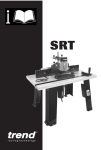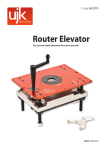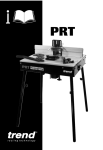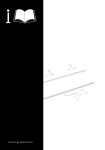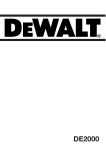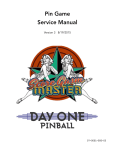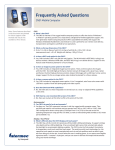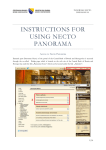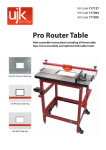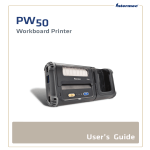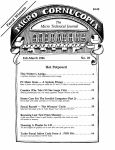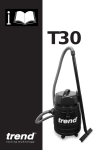Download Craftsman pmn Instruction Manual
Transcript
trend routing technology ROUTER TABLE for the Craftsman Instruction Manual Model Numbers: CRT/A CRT/B CRT/C CRT/D CRT/E CRT/X Trend Machinery & Cutting Tools Ltd. Penfold Works Imperial Way Watford Hertfordshire WD2 4YF England Sales: _________________ 01923 249911 Technical Enquiries: ____ 01923 224681 Fax: ___________________ 01923 236879 Email: _______ [email protected] WWW: ____ http://www.trendm.co.uk R Router Table for thefrom Craftsman Routing Products the UK Leader Dear Customer Thank you for purchasing the Trend Router Table for the Craftsman. We hope you enjoy many years of creative and productive use of this product. Trend welcomes comments on this and all our products in our aim to develop and improve what we do to meet the needs of you, the customer. Please contact our Technical Department in the first instance if you have any comments or queries. Trend is the UK's leading supplier of router cutters, equipment and accessories. Our Craft Range of Cutters referred to in this manual, is designed specifically to meet the needs of amateur craftsmen and woodworking enthusiasts in quality and value. For the professional woodworker, the Trend Professional Range of Routing Products has become the industry's standard guide to the most comprehensive range of router cutters and related products available in the UK. Please contact your nearest Trend stockist to obtain any of our products and for a copy of the latest Trend Routing Catalogue. -1- MANU/RTv5 Router Table for the Craftsman INTRODUCTION CONTENTS ________________________ Page This Router Table is designed for the woodworking Craftsman and especially those new to the art of routing. Contents, Introduction, Tools Required _______ 1 Safety Precautions, Specs, Cutter Care, Advice 3 Assembly Instructions The Router Table has the necessary features to extend the versatility of most portable routers when profiling, edging, rebating and jointing. A. Assembly of Legs ________________________ 5 The table includes the following features: B. Mounting Table to Workbench or Workboard ___ 5 ● A large machined aluminium Table Surface C. Mounting Table to a Workmate _____________ 5 ● ● A Back Fence with Workpiece Support and Dust Extraction Point A clear Retractable Safety Dust Guard ● An adjustable sliding Mitre Fence D. Identification of Mounting Holes and Screws ___ 8 E. Re-Drilling of Router Base _________________ 8 F. Re-Drilling of Insert Plate __________________ 9 ● A sliding Push Block for producing tenons G. Re-Drilling of Insert Plate and Router base ____ 9 ● A pre-drilled Insert Plate to fit most popular routers H. Fitting Insert Plate to Table Surface _________ 10 ● K. Fitting Lead-on Pin ______________________ 11 ● Insert Rings to reduce the 2 1/8" (54mm) cutter aperture A Lead-on pin for safer profiling with bearing guided cutters without a Back Fence No-Volt Release Switch - 230 volts L. Assembly & Mounting of Tenon Push Block __ 13 ● Plastic Pushstick I. Fitting Router to Insert Plate _______________ 10 J. Selecting & Fitting Insert Plate Rings ________ 11 ● M. Assembly of Safety Dust Guard to Back Fence 13 The following Optional Extras are also available through your Trend stockist: N. Assembly of Back Fence _________________ 15 P. Attachment of Back Fence to Table _________ 15 Q. Assembly & Alignment of Mitre Fence _______ 17 R. Fitting of No-Volt Release Switch ___________ 17 Optional Accessories S. Dust Extraction Equipment ________________ 18 ● Spring Pressure Clamps ● Safety Profiling Top Guard ● Extraction Hose and Adaptor TOOLS REQUIRED FOR ASSEMBLY OF TABLE T. Assembly of Spring Pressure Clamp ________ 19 A set of spanners and a screwdriver are required for the initial assembly of the table. Additional screws or nuts/ bolts will be required for mounting the table to a suitable surface. U. Assembly of Profiling Top Guard ___________ 20 Operation V. Edging & Profiling using the Back Fence _____ 21 Spanners 8mm, 10mm and 11mm W. Using Router Table for Grooving ___________ 22 X. Using Mitre Fence ______________________ 22 Y. Using the Profiling Top Guard _____________ 24 Screwdriver with flat head Z. End Cutting with the Tenon Push Block ______ 26 Spare Parts Diagram ____________________ 28 MOUNTING OF ROUTERS Appendix Most popular makes of router can be mounted to the table, providing the correct model of table is purchased. Additional modification may be required for certain models of router and are described in sections E to G. Additional tools may be required to make these modifications. Plan for base of Hitachi TR12 _________________ 30 Plan for base of Ryobi R600, RE600 ___________ 31 Plan for base of Skil 1835U, 1875U1 ___________ 32 Plan for base of Elu MOF96(E) Mk1 Choice of router will depend on shank size of cutters that will be used. Higher powered routers will be required for using larger diameter cutters or for making heavier cuts. Additional plates can be purchased if more than one type of router is to be mounted to the table. and other similar makes _____________________ 33 Plan for the Elu OF97(E) gasket _______________ 34 Plan for the Bosch POF52, 400A, 500A & 600 ACE gasket __________________________ 35 -2- Router Table for the Craftsman SAFETY PRECAUTIONS CUTTER CARE 1. Always switch off the power and unplug the router when changing cutters or when making adjustments. 1. Do not drop cutters or knock them against hard objects. 2. Always wear protective goggles when routing. 2. 3. Wear sound protective ear muffs when routing for long periods of time. 4. Cutters should be kept clean. Resin build-up should be removed at regular intervals with a wire brush. The use of a dry lubricant will act as a preventative eg Trendicote spray. Take care not to allow excessive quantities of lubricant to come into contact with the Router Table. Do not wear loose clothing. Make sure baggy sleeves are rolled up and ties are removed. 3. Cutter shanks should be inserted into the collet at least 3/4 of shank length to prevent distortion. A distorted collet should be discarded, as it can cause vibration and damage the shank. 4. Do not overtighten collet as this will score the shank and create a weakness there. 5. It is also advisable to periodically check the router collet nut for wear. 5. Always remove spanners and allen keys from the table surface before switching router on . 6. Keep hands well clear of the router cutter when routing. 7. Avoid accidental starting of the router. Make sure the power switch is in the 'Off' position before plugging in and connecting to the electrical supply. Fit the no-volt release switch for ultimate safety. 8. 9. Never leave the router unattended when running. Always wait until the router comes to a complete stop before making any adjustments. USEFUL ADVICE Do not switch the router on with the cutter touching the workpiece. 1. Judge your feed rate by the sound of the motor. In time, the operator will acquire a ‘feel’ for the router, and a feed speed relative to the work will come naturally. Too slow a feed will result in burning. 2. Do not take too deep a cut in one pass. Take light cuts with many passes to maintain cutter speed and improve finish. 3. Apply the normal precautions as with any electric power tool. 4. The main abuse of routing machines is the inclination for operators to overload them. The motto is 'Keep the revs up'. The drop in revolutions should not exceed, if possible, more than 20% of full running speed. 5. The motor of a router is susceptible to the accumulation of sawdust and wood chips, and should be blown out, or ‘vacuumed’ , frequently to prevent interference with normal motor ventilation. 6. Do not store the Router Table with router fitted on the floor, as chips, panel pins or dirt could drop into the air intake of the router. 10. Make a push stick and use it to move narrow workpieces across the cutting area. 11. Mount the Router Table securely to a work bench or to a workboard fitted to a suitable surface. 12. Check the function of the retractable safety guard before each use, to ensure it rides easily over the workpiece. 13. Always use the back fence to guide the work. Do not work freehand unless using bearing guided or pin guided cutters. 14. Always feed the workpiece against the rotation of the cutter 15. Periodically check all nuts and bolts to make sure they are tight and secure. 16. Use dust extraction equipment. SPECIFICATIONS: Table surface 359mm (14") x 610mm (24") 7. Refer to the Instruction Manual supplied with your router for full details of it's features and safety information. Table height 349mm (13 1/2") 8. The use of a fine height adjuster is highly recommended (if available for your router) for accurately adjusting the height of the cutter. 9. Do not use strong detergents or organic solvents to clean the Router Table or any of its components. 1 Aperture opening 54mm (2 /8") Back Fence opening 73mm (2 7/8") Height of Back Fence 100mm (4") -3- Router Table for the Craftsman Table Components Table Surface x1 Nuts x 12 Table Leg x2 -4- Star Washers x 12 Dome Headed Screws x 12 Router Table for the Craftsman ASSEMBLY INSTRUCTIONS Leg A. Assembly of Legs 1. Identify the components required, see opposite 2. Turn the Table Surface face down. 3. Locate one of the Table Legs at one end of the Table Surface as shown in figure A. 4. Insert the Dome Headed Screws through the six holes in the Table Surface and Table Leg. Six screws are required for each of the two Table Legs. 5. Lightly tighten the Nuts and Star Washers on to each Dome Headed Screw. The Star Washers should be against the inside of the Table Leg. 6. Repeat for the second Table Leg. 7. Turn the table assembly the correct way and tighten all 12 Nuts with a 10mm spanner (not provided). B. Mounting Table to Workbench or Workboard Table screw Star Nut washer Fig. A The Router Table must always be mounted onto a suitable workbench or workboard for stability. Each Table Leg has three slotted holes at the bottom mounting. Firmly secure the table assembly to a workbench or workboard, using appropriate bolts and wing nuts (not provided) as shown in fig. B. The slots are 6mm wide x 16mm long and will accommodate bolt sizes up to M6. Table leg If a workboard is used, this will allow quick mounting and removal from a workbench by using G clamps. C. Workboard or Workbench Mounting Table to a Workmate Fig. B The Router Table can also be fiited by using No. 12 selftapping screws (not provided) through the centre holes in the legs to a 125mm (5") batten, which will enable the Router Table to be quickly mounted and removed from a Black & Decker Workmate ® or similar workmate by simple clamping the batten between the jaws. See fig. C. (125mm) 5" wide Batten Self tapping screw Workmate® Fig. C -5- Router Table for the Craftsman CRT/PLATE A (inc. Fixing Pack) supplied with Router Table CRT/A Fixing Pack Router Models M4 x 12mm (3) M6 x 10mm (2) A2 M6 x 12mm (3) B C M6 x 25mm (3) C M6 x 16mm (3) A1 A1 M6 x 35mm (3) Spring washer (3) B C Threaded hole for Lead-On pin 3/4" x1/4" Washer (3) M6 nut (3) Holes Fixings Following models will fit insert plate Elu MOF 69, 96(E) Mk 2 A1 A1 Elu OF97(E)● Elu MOF 131, 177(E) A1, A2 Bosch POF 52,400,500A,600ACE● B Bosch GOF 1600A, 1700ACE A1, A2 Black & Decker BD780(E), KW780(E) C Dewalt DW613 A1 M6 x 10 M6 x 16 M6 x 12 M6 x 12 M6 x 12 M4 x 12 M6 x 10 Require re-drilling of router base, see Section E B B M6 x 25▲ M6 x 25▲ B A1 B A1 B B M6 x 25▲ M6 x 35▲ M6 x 25▲ M6 x 35▲ M6 x 25▲ M6 x 35▲ Holes Fixings Elu MOF 96(E) Mk 1* Black & Decker SR100* AEG OFS450S, OFS50, OFS720 & OFSE850* Metabo OF1028◆, OFE1229◆ Perles OF808, Stayer PR50* Ryobi R500◆, R502◆ Kango R8550S, Holzher 2335, 2355 Virutex FR77C, 78C * see page 33 CRT/PLATE B (inc. Fixing Pack) supplied with Router Table CRT/B Fixing Pack D Router Models Following models will fit insert plate D M4 x 12mm (4) Hitachi M8◆, M8V◆ Peugeot DF55E, DEF570E Ryobi RE120, R150, R151 Makita 3620 M5 x 10mm (4) Require re-drilling of insert plate, see Section F E F F E D D M5 x 16mm (2) D E E F M5 x 10 M5 x 16 M5 x 16 M5 x 16 Hitachi TR12◆ (see page 30) - M5 x 10 Ryobi R600◆, RE600◆ (see page 31) - M4 x 12 M5 x 16 Threaded hole for Lead-On pin CRT/PLATE C (inc. Fixing Pack) supplied with Router Table CRT/C Fixing Pack H G1 I Router Models M4 x 12mm (2) Fixings M4 x 20mm (1) Black & Decker BD66◆ M6 x 25mm (3) G2 M8 x 20mm (2) Bosch GOF 900A, 900ACE Ryobi RE600N◆, R600N◆ G1 G2 H I M4 x 12 M4 x 20 M6 x 35 ■ M8 x 20 I G1 H Holes Following models will fit insert plate H Threaded hole for Lead-On pin Spring washer (3) 3/4"x1/4" Packing Washer (9) M6 nut (3) 6mm Washer (3) -6- ◆ Remove plastic base of router before fitting router to insert plate ▲ Requires fitting of washer, spring washer and nut ● Requires user made packing piece/gasket, please see end of section D.4.(i) on page 8 ■ Requires fitting of washer, spring washer, nut and three 3/4"x1/4" packing washers which are placed between plate and router base for each fixing Router Table for the Craftsman CRT/PLATE D (inc. Fixing Pack) supplied with Router Table CRT/D Fixing Pack Router Models M4 x 12mm (4) J2,K2 Holes Fixings Following models will fit insert plate J2,K2 K1 Makita 3612BR J1 M5 x 16 J2 M4 x 12 K1 K2 M5 x 16 M4 x 12 M5 x 16mm (2) Makita 3612, Makita 3612C J1 J1 J2,K2 K1 J2,K2 Threaded hole for Lead-On pin CRT/PLATE E (inc. Fixing Pack) supplied with Router Table CRT/E M Fixing Pack L Holes AEG OFSE2000 L M6 x 25 Bosch GOF1300ACE M M6 x 35 ■ Freud FT2000(E) L M6 x 12 Hitachi M12V/M12SA N M5 x 10 M6 x 12mm (3) M6 x 35mm (3) L L N M N 3/4"x1/4" Packing Washer (9) M6 nut (3) 6mm Washer (3) M Threaded hole for Lead-On pin CRT/PLATE X Spring washer (3) Fixings Following models will fit insert plate M5 x 10mm (4) N N Router Models (inc. Fixing Pack) supplied with Router Table CRT/X Fixing Pack Router Models Holes M6 x 12mm (3) Skil 1835, 1875UI - see p.32 - No.10-32UNF x 3/8" (3) Threaded hole for Lead-On pin No.10 - 32 UNF x 3/8" M6 x 35mm (3) Spring washer (3) Fixings Require re-drilling of insert plate, see Section F Festo OF900(E), OF2000(E) - M6 x 35▲ Hitachi FM8, ZK2008 - M6 x 35▲ 3/4"x1/4" Washer (3) M6 nut (3) -7- ◆ Remove plastic base of router before fitting router to insert plate ▲ Requires fitting of washer, spring washer and nut ● Requires user made packing piece/gasket, please see end of section D on page 8 ■ Requires fitting of washer, spring washer, nut and three 3/4"x1/4" packing washers which are placed between plate and router base for each fixing Router Table for the Craftsman D. base. The fixing screws can then be used to secure. The use of a gasket serves two purposes, firstly it allows for secure fixing of the router, and secondly, due to the small aperture in the router it allows the tabs of the insert rings to fit tightly to the plate. Enlarging the aperture in the base of the router is also advised if large diameter tooling is to be used. Identification of Mounting Holes and Screws See previous page to: 1. Identify which Insert Plate has been supplied with your Router Table. 2. Identify the mounting holes and fixing screws (including washers & nuts if applicable) which will be required to suit your router. 3. (iii) For Bosch GOF900A and 1300ACE, three 3/4"x1/4" packing washers are used on each screw to pack out the base of the router from the underside of the insert plate. These packing washers allow the tabs of the inset rings to fit tightly in the plate. Identify whether your router or the Insert Plate requires re-drilling. If at this point, you realise you have ordered the incorrect model of Router Table for your router, an exchange of the Insert Plate can be made direct with Trend, see address on front cover. Ensure that the fixing pack, insert rings and insert plate are returned. Please quote part number of plate required in the exchange. Additional Insert Plates can be purchased through your nearest Trend stockist if you wish to fit other models of router to your router table. See prevoius page for selection, and spare parts diagram for price details. 3/4" & 1/4" packing washers Your Router should fall into one of the following catagories: (i) No adjustment necessary - Proceed to section H. Please note for Elu OF97(E) see section (i) below. For Bosch POF 52, 400A, 500A and 600ACE see section D4 (ii) and for Bosch GOF900A and 1300ACE see section D4 (iii). (ii) Router base requires re-drilling - Proceed to section E (iii) Insert Plate requires re-drilling - Proceed to section F 4.(i)For the Elu OF97(E) a 6.35mm (1/4") thick MDF or plywood gasket is required. The central hole should be drilled out to 60mm in diameter and with two Bosch GOF900A & 1300ACE further holes of 8mm diameter and at 115mm centres. Please see page 34 for plan. (ii) For the Bosch POF DIY range of DIY routers a special gasket must be made in 3mm to 6mm thick plywood or MDF made. Please see page 35 for plan. This gasket is then placed between the underside of the plate in the table and the underside of the router E. Re-drilling of Router Base 1. Invert your router onto a suitable surface. 2. Place the Insert Plate facing upwards onto the base of your router. 3. Identify holes A1 and A2, or holes B on the Insert Plate. 4. Fit a large diameter cutter (max. 53mm diam.) into your router and tighten collet. 5. Retract plunge mechanism and lock off allowing cutter to protrude through the base. 6. Adjust position of the Insert Plate to centralise the cutter within the centre hole of the Insert Plate. 7. Ensure that the threaded hole in the Insert Plate faces the same side as on/off switch and fine height adjuster (if fitted) so as these are easily accessible when the router is fitted to the table. 8. Ensure that the holes you are about to drill in the base do not interfere with any of the features on the Packing piece Bosch POF52, 400A, 500A & 600ACE -8- Router Table for the Craftsman 10. router or any webbings in the casting of the router base. A slight turning of the plate may be required to miss such obstructions. (i) Note If you do not have the necessary equipment to carry out operations 7 and 8, then a local engineering shop will be able to carry them out accurately. The base of the following routers must be drilled with two 6mm diameter holes: MOF96(E) Mk1 Black & Decker SR100 AEG OFS450S, OFS50, OFS720, OFSE850 Perles OF808, Stayer PR50 Kango R8550S, Holzher 2335, 2355 Virutex FR77C, 78C G. Re-drilling both Insert Plate and Router Base 1. Invert the router and lay the insert plate onto the upturned base, ensuring threaded insert hole is in the correct position. The base of the following routers must be drilled with two 6mm diameter holes: 2. Metabo OF1028, OFE1228 Ryobi R500, R502 Clamp the insert plate and router base together with two cramps. 3. Ensuring that the drill bit will not foul any webbing or fixtures on the router base, drill with a 6mm diameter drill bit into the insert plate and through the router base two holes approximately 75mm apart. 4. Unclamp the router base and insert plate. 5. Countersink the insert plate holes with a countersink bit to a depth so the screw heads are slightly below the top surface. Clean off any burrs created on both the insert plate and router base. Please see page 33 for plan. Holes B on the plate will be used. (ii) Countersink the hole with a countersink bit to a depth so the heads of the screws are slightly below the top surface. Clean off any burrs created. Holes A1 on the plate will be used. 9. Mark the centre of the holes onto the base. 10. Remove plate and mark the centre of the holes with a centre punch. 11. Drill a hole at these points with a 6mm diameter drill bit. 12. Clean up edges of holes if required. F. Re-drilling of Insert Plate 1. Remove or photocopy the plan from the appendix of this manual. 2. Invert the router and lay the plan onto the base. 3. Identify the appropriate holes on the plan to fit your model of router. 4. Line up the plan with the holes on the router and check the accuracy of their positions. 5. Draw cross lines on the insert plate with a pencil. These cross lines bi-secting the plate on both sides. 6. Cut around the plan of the router base so that the cross lines drawn on the paper plan are dissected. 7. Line up the lines on the insert plate and the lines on the paper plan, ensuring that the threaded insert hole match. Stick the paper plan onto the insert plate. 8. Using a centre punch, mark centres of holes. 9. Drill the required hole size with a suitable metal drill bit . Best results will be obtained if your power drill is mounted in a drill stand. -9- Router Table for the Craftsman H. Fitting Insert Plate to Table Surface 1. Identify the components required, see below. Nylock Nut with Nylon ring facing up Insert Plate Adjustable Bolts x4 Insert Plate Retaining Bolts x4 Insert plate adjustment bolt Nylock Nuts x 8 Fig. G.1 2. Assemble the four Insert Plate Adjustment Bolts and the four Nylock Nuts to table as shown in fig. G1. After a few turns some resistance will be felt as the screws are gripped by the Nylock Nuts. Screw just enough to leave a few threads protruding through the nut. 3. Place the Insert Plate into the large opening in the table. The position of the plate should be with the Threaded Hole to the front right of the Table Surface, see fig. G2. 4. 5. Fig. G.2 While pressing down on the Insert plate, gradually adjust the Insert Plate Adjustable Bolts with a screwdriver until the Insert Plate is level with the Table Surface. A steel rule or T-square can be placed on the top of the Insert Plate to help this levelling process. The Insert Plate must be be supported equally on all four Insert Plate Adjustment Bolts. When pressure is applied, the Insert Plate should be stable. Insert plate retaining bolt Insert the four Insert Plate Retaining Bolts and fit the four Nylock Nuts to secure the Insert Plate to the Table Surface, and tighten securely, see fig. G.3. Nylock Nut with Nylon ring facing down Fig. G.3 I. Fitting Router to Insert Plate 1. Turn the table onto its side, invert the router and line up the Mounting Holes in the Insert Plate, as identified in section D, with the appropriate securing points in the base of the router. 2. Insert the correct Router Fixing Bolts, as identified in section D, through the Insert Plate and into router base. Fit appropriate washers and nuts if applicable, see fig. H. Threaded hole for Lead-on Pin Note Some models of router will require removal of plastic base prior to fitting, see Section D and pages 6 and 7. Fig. H -10- Router Table for the Craftsman J. Selecting & Fitting Insert Plate Rings The Insert Plate Rings are designed to support the workpiece around the cutter to avoid small timber sections tipping or flexing when being machined. 1. First separate all Insert Plate Rings from each other using a sharp knife and trim off all flashes, see fig. J.1. Selecting the correct size of Ring 2. Select an Insert Plate Ring with an inside diameter approximately 1/4" (6mm) larger than the maximum diameter of the cutter to be used. This will give 1/8" (3mm) gap around the cutter to allow the chips to clear. 3. An Insert Plate Ring is not required for cutters having a diameter of 1 3/4" (45mm) or larger, as the Insert Plate will provide enough support for the workpiece. 4. Trim flash here Do not use router cutters having diameters larger than 50mm (2"). Always ensure the aperture on the base of your router will allow the cutter to protrude through it without touching it. Fitting Insert Plate Rings Fig. J.1 The Insert Plate Rings are designed to be snapped into the Insert Plate. Slide the large tab under the edge of the Aperture Hole in the Insert Plate as shown in fig. J.2. 5. Using you thumb, press down on the Insert Plate Ring until the small tab snaps into position. Ensure the Insert Plate Ring is fully seated into the Aperture Hole. 6. To remove the Insert Plate Ring, release the small tab from the edge of the Aperture Hole and pull the Ring out. K. Fitting Lead-on Pin The Lead-on Pin is a safety feature for profiling straight or shaped workpieces with a bearing guided cutter without using a back fence. It will prevent the cutter from snatching the workpiece, especially when using larger cutters or when making heavier cuts. The use of the optional accessory Profiling Top Guard is highly recommended to safely carry out this type of routing operation. See section Y for more information. Insert plate ring Fig. J.2 Guide pin Identify the Lead-On Pin, see below. Lead-on Pin x 1 1. Screw the Lead-on Pin by hand into the Threaded Hole in the Insert Plate, see Fig. K. 2. With a flat screwdriver tighten the pin securely. 3. When you do not require the Lead-on Pin, keep it in a safe place as it is easily misplaced. Insert Plate Ring Fig. K -11- Router Table for the Craftsman Tenon Push Block Components Clamp Rod x 1 Spring Washer x1 Nut x 1 Washer x 1 Wing Nut x 1 Clamp Plate x 1 Push Block x 1 Safety Dust Guard Components Pivot Pin x 1 Push Nuts x 2 Dust Guard x 1 (not shown actual size) -12- Router Table for the Craftsman L. Assembly of Tenon Push Block 1. Identify the components required, see opposite. 2. Screw the smaller threaded end of the Clamp Rod into threaded hole in Clamp Plate until the plate bottoms on it’s shoulder (make sure clamp is oriented such that letter 'C' is facing outwards as shown in fig. L.1) and tightly secure Clamp Plate to Clamp Rod with a 11mm AF spanner. 3. Hex nut Spring washer Small threaded end Shoulder Long threaded end Clamp plate Insert the longer threaded end of Clamp Rod through hole in Push Block and fit the flat washer and the Wing Nut onto it. Flat washer Clamp rod Push block Fig. L.1 Mounting Push Block Assembly on Back Fence 1. 2. Mount assembled Push Block on the Back Fence by aligning retaining rib on Push Block with the groove in the face of Back Fence. See fig. L.2. Clamp plate Slide push block assembly back and forth along entire length of Back Fence to ensure that it slides freely. Occasional application of furniture spray wax on the sliding surfaces of the Push Block will improve the sliding motion. Removing dust and chips from sliding surfaces of Push Block and Back Fence will ensure a good sliding motion. Face of back fence Push block M. Assembly of Safety Dust Guard to Back Fence 1. Identify the components required, see opposite. 2. Position the guard on the Back Fence as shown in fig. M. 3. Fit one of the Push Nuts onto one end of the Pivot Pin. (To ensure a secure fitting it will be necessary to tap it onto the pin with a hammer). 4. Align the holes in the Back Fence with those on the Dust Guard. 5. Insert the Pivot Pin through the holes. 6. Fit the remaining Push Nut onto the other end of the Pivot Pin. It will be necessary to support the other end of the Pivot Pin onto the corner of a hard surface in order to tap the Push Nut securely onto the Pivot Pin with a hammer. 7. Ensure the guard pivots freely. Note Once the guard has been installed, it is recommended that the Push Nuts are not removed. Fig. L.2 Fig. M -13- Wing nut Router Table for the Craftsman Back Fence Components Back Fence x 1 Workpiece Support x 1 Medium Size Knob x 1 Large Size Knob x 2 Washer x 1 Washer x 2 -14- Workpiece Support Adjustment Bolt x 1 Back Fence Fixing Bolts x 2 Router Table for the Craftsman N. Assembly of Back Fence 1. Identify the components required, see opposite. 2. Slide Workpiece Support through rectangular opening in the aperture provided in the Back Fence. The V-guide on the Back Fence should engage in the V-guide on the under side of Workpiece Support, see fig. N and page 21 for use. Knob (medium size) 3. 4. Flat washer Aperture Insert the Workpiece Support Adjustment Bolt through the hole in the underside of the Back Fence and through the slot in the Workpiece Support. While holding the head of the bolt in the hex recess on the underside of Back Fence, place the flat washer over the bolt and screw on the Medium Size Knob. Slot Workpiece support Fig. N Back Fence Fixing Bolt When knob is loosened, the Workpiece Support should slide back & forth in the aperture for take-up adjustment. P. Attachment of Back Fence to Table The Back Fence is provided as a guide against which the workpiece should be held for accurate routing. Freehand routing (not holding work against the fence) should be avoided unless the cutter has a bearing guide or pin. Then, the Lead-on Pin should be fitted to prevent the cutter from snatching the workpiece. When attaching the Back fence to the Table Surface, care should be taken not to knock the protruding cutter, if it has already been fitted. Two round holes on the right side of the Table Surface and one long slot on the left hand side of the Table Surface are provided for attaching the Back Fence. Fig. P.1 For all edge cutting and end cutting operations, attach fence using the front hole and the slot. This will allow adequate adjustment of the Back Fence to suit the cutter diameter and depth of cut. See fig. P.2. For all routing operations away from edge on the under side of workpiece, such as grooving, fluting, veining, attach the Back Fence using the back hole and the slot. See fig. P.3. Dust extraction should be used with the Back Fence at all times to prevent clogging of wood waste, see page 18. 1. Position Back Fence assembly to Table Surface as shown in fig. P.1. 2. Depending upon the type of routing operation, insert one of the Back Fence Fixing Bolts through one of the holes on the right side of the Table Surface (from the underside) and the short slot in the Back Fence. Make sure square shoulder of the bolt fits into the square recess in the underside of the Table Surface. 3. While holding the bolt in place, fit the flat washer and large knob onto the bolt to secure loosely the Back Fence to the Table Surface. 4. Repeat Steps 2 and 3 for table slot and fence slot on the left hand side of the Table Surface. Fig. P.2 Fig. P.3 -15- Workpiece support adjustment bolt Router Table for the Craftsman Mitre Fence Components Mitre Fence Head x 1 Small Size Knob x 1 Bolt x 1 Washer x 1 Pointer x 1 Securing Bolt x 1 Nut x 1 Mitre Bar x 1 -16- Router Table for the Craftsman Q. Assembly of Mitre Fence 1. Identify the components required, see opposite. 2. Insert the pin of the Mitre Fence Head into the Mitre Bar. 3. Insert the Securing Bolt and fit the Flat Washer and Securing Knob (small size). 4. Remove any flash on the plastic pointer with a sharp knife. Knob Flat washer Mitre fence head Knob 5. Pointer Mitre bar Position the pointer as shown in fig. Q.1 and insert the bolt, then fit the nut. Securing bolt Hex nut fig. Q.1 Alignment of Back Fence to Mitre Fence Slot 1. Measure the distance from each end of Back Fence to edge of Mitre Fence slot in the Table Surface as shown in fig. Q.2. Adjust the position of the Back Fence to ensure both distances are equal. 2. Position Mitre Gauge in slot as shown in fig. Q.2. R. No-Volt Release Switch - NVRS/230V (Standard accessory on tables made from 1/3/97) fig. Q.2 The No-volt Release Switch can be fitted to the table leg or workboard to provide easy access to On/Off buttons. Should the power be turned off at source, the router will not restart until the green start button is pressed. The switch is for use with 230 volt routers up to 1850 watts. 1. With the fixing kit supplied, mount the No Volt Release Switch on the right side of the router table using the holes already drilled. to plug at mains supply to socket for plug of router fig. U.1 workboard fig. U.2 -17- Router Table for the Craftsman OPTIONAL ACCESSORIES swivel freely when fitted to the hose. R. Dust Extraction Equipment Assembly of Hose Adaptor The Back Fence is provided with an extraction point for fitting to suitable dust extractors. The internal hole diameter is 57mm (2 1/4"). Suitable fittings with 57mm outside diameter are available with most extractor units. 1. Slide Adaptor Clip onto end of the Extraction Hose CRT/4 with tabs facing outwards. 2. Screw the Adaptor Fitting anti-clockwise onto hose, ensuring that the Extraction Hose is screwed in all the way. A suitable adaptor and extraction hose can be purchased as optional accessories as follows: 3. Fit the Adaptor Tube by locating the holes with the tabs of the Adaptor Clip. Extraction Hose - 39mm OD - 3 metre length.........CRT/ 4 Hose Adaptor - 58mm OD to 39mm ID..................CRT/3 4. Push the assembly into the back fence connection point with a slight twisting action to ensure a tight fit. The hose has an outside diameter of 39mm and inside diameter of 32mm and is designed to fit the hose adaptor. The hose adaptor is a unique design allowing it to 5. Fit the other end of the extraction hose to your dust extractor. Only a dust extractor unit recommended for use in the workshop should be used. Extraction Hose - CRT/4 Hose Adaptor - CRT/3 Extraction Point Back Fence Hose Adaptor CRT/3 Extraction Hose CRT/4 57mm Adaptor Tube Tabs Adaptor Fitting Adaptor Clip 39mm fig. R -18- Router Table for the Craftsman T. 6. Assembly of Spring Pressure Clamps The Optional Spring Pressure Clamps can be mounted to the Back Fence. When adjusted to suit the width and thickness of the material, it ensures the material is held down onto the surface to obtain accurate machining of the workpiece. The Back Fence is pre-drilled to accept both Spring Pressure Clamps. 1. Remove Back Fence from Table Surface 2. Insert Vertical Pillar Bolt through the underside of the Back Fence. 3. Fit washer and screw on the Vertical Pillar. Tighten screw securely to ensure pillar is vertical. 4. Fit knobs to Connector Block and slide it onto Vertical Pillar. 5. Slide Horizontal Bar through Connector Block. Slide Pressure Strip into the slot in Horizontal Bar aligning the holes. Insert the Retaining Screw ensuring it goes in through the un-threaded side of the hole first. Before tightening the Vertical Pillar Bolts, ensure that the Vertical Pillar will allow the block to be positioned parallel to the Back Fence with the knob engaging on the flat of the Vertical Pillar. Adjustment The Spring Pressure Clamps will require adjusting to suit the height and width of material being routed. The Pressure Strips should provide enough pressure to prevent the material lifting from the Table Surface, but not too much as to create friction which would prevent the material from sliding freely. The block assembly with Horizontal Bar and Pressure Strip can be removed from the Vertical Pillars when not required. The Vertical Pillars can be left in position and will not impede the Tenon Push Block system. Spring Pressure Clamp Set - CRT/10 Pressure Strip Slot Retaining Screw 3mm Allen Key Knob Connector Block Horizontal Bar Vertical Bar Washer Vertical Pillar Bolt 4mm Allen Key fig. S -19- Router Table for the Craftsman U. Adjustment Assembly of Profiling Top Guard The use of the optional accessory, Profiling Top Guard is highly recommended to safely carry out the profiling of workpieces with a bearing guided cutter. It will prevent the operator's fingers inadvertantly contacting the cutter. Fit the Bolt, Star Washer, Spring Washer and Nut in the sequence as indicated below. 1. 2. Tighten nut securely with a 8mm spanner. 3. Fit Plate, Washer and Wing Nut. 4. Slide the Perspex Guard in between the Plate and edge of Table Surface. 5. Gently tighten Wing Nuts. 1. The height of the Perspex Guard should be adjusted to leave a 6mm to 12mm gap between the top of the workpiece and the underside of the guard. This will prevent fingers coming into contact with the cutter. 2. To adjust the height undo the wing nuts, re-position the guard and retighten. Section Y describes a typical application involving the use of bearing guided cutters with the Router Table. Profiling Top Guard - CRT/2 Perspex Guard M5 Bolt Star Washer Spring Washer Half Nut Plate Washer Wing Nut fig. T -20- Router Table for the Craftsman OPERATION V. Edging and Profiling using the Back Fence The router table has many advantages when profiling and edging operations are to be carried out especially on narrow workpieces. A Fine Height Adjuster fitted to the router will make adjustment of the height far easier and hence is highly recommended. Craft Range Ref. C020 Craft Range Ref. C072 Craft Range Ref. C040 Craft Range Ref. C112 Craft Range Ref. C110 NOTE: Make a test cut on a piece of waste material prior to carrying out any routing operation. 1. Mark the width and depth of cut required onto the end of the timber. See fig. V.1 for typical profiling and edging operation which can be carried out. 2. Place timber up against Back Fence. 3. Release Back Fence Fixing Bolts. 4. Adjust Back Fence until required width of cut is achieved. See fig. V.2a. Craft Range Ref. C094 fig. V.1 If bearing guided cutters are used, ensure that the Back Fence is in line with the bearing or slightly behind it. The Back Fence will give more support and provides the retractable Safety Dust Guard and Spring Pressure Clamp facility. 5. Lock Back Fence Fixing Bolts. 6. Release plunge mechanism on router. 7. Adjust the depth of cut using the Fine Adjuster (if fitted), see fig. V.2b. 8. Lock-off plunge mechanism of router. 9. Lower Safety Dust Guard and check it will retract freely over the workpiece. 10. Adjust the Spring Pressure Clamps (if fitted) to suit the thickness and width of the timber. 11. Ensure that you have a Pushstick within easy reach when routing. 12. Switch on router. 13. Pass timber over cutter with a consistant feed speed. fig. V.2a fig. V.3a Ensure even pressure is kept on the workpiece down onto the table and against the back fence. Always ensure that your hand positions are never near the cutter. Use the correct procedure as shown in figs. V.3a - c. Use the push stick to safely maintain pressure on narrow timbers. 14. fig. V.3b The Workpiece Support can be used to plane an edge. The cutter should be set approximately 2mm proud of the Back Fence. The material should be routed until the planed edge passes onto the outfeed fence. Switch off router, slide or pivot material away from cutter. Replace material and bring Workpiece Support out until it touches the material. Tighten knob and continue routing. fig. V.3c -21- fig. V.2b Router Table for the Craftsman W. Using Router Table for Grooving The router table can be used for operations away from the edge of the workpiece such as grooving, fluting, veining, etc. Always unplug the router before making any setting, adjustments, or changing bits. When routing, always feed against the rotation of the cutter. Feed workpiece in the direction of arrow in fig. W.2. For maximum accuracy, one edge of your workpiece (edge sliding against the fence) must be true and straight. Set up your fence as follows: 1. fig. W.1 Raise Safety Dust Guard and rest it against the extraction point. 2. Position the fence behind the router bit for the desired cutting depth (the distance of cut from the edge of the workpiece, as shown in fig. W.1). 3. Securely tighten Back Fence Fixing Bolts and lower the guard over the cutter. 4. Make the cut by sliding the straight edge of workpiece against the fence. Use a Pushstick as shown in fig. W.2. (For each successive cut, the fence would need to be re-adjusted). pushstick fig. W.2 X. Using Mitre Fence Your Mitre Fence will be required to give extra support for routing small workpieces or ends of large workpieces. See fig. X. NOTE: For all routing operations requiring use of the Mitre Fence along with the fence, be sure to align fence with mitre bar slot before making any cuts. It is advisable to fit a waste piece of material to the Mitre Fence or behind the component to prevent breakout of the wood grain. If using Mitre Fence to trim the end off a piece of material, the Workpiece Support can be brought forward with the cutter to support the material after the cut, see fig. X. fig. X -22- Router Table for the Craftsman Craft Range Cutter Ref. C116 Guard Template 6mm Lead-on Pin Table Surface Insert Plate Insert Ring fig. Y.1 Craft Range Cutter Ref. C078 Guard 6mm Table Surface Lead-on Pin Insert Plate fig. Y.2 -23- Router Table for the Craftsman Y. Using The Profiling Top Guard b. Gradually swing workpiece towards cutter until template engages the guide bearing. Example c. Feed workpiece against the rotation of the cutter whilst swinging the workpiece away from the Lead-On Pin. At this point the guided bearing is acting as the guide. Progressively feed the workpiece anti-clockwise around the shape of the template ensuring that the guide bearing always stays in contact with the template. A typical application using the Profiling Top Guard is in the routing of shields from MDF Board (Medium Density Fibreboard) as follows: d. When the complete edge of the workpiece has been machined, slide the workpiece away from the cutter. If you are unfamiliar with the above procedure then the technique should be practised before switching on the router. Design of shield Producing a Shield 1. Construct an actual size template of the shield design from 6mm MDF, hardwood or plywood ensuring that it is accurate and free from imperfections. Remember the finished product will only be as good as the template. Special Notes 1. Always keep the workpiece moving in a precise steady movement to prevent the material from burning. 2. Never let go of the workpiece. Always keep an even pressure of the workpiece against the bearing. Do not use too much pressure. 3. If you wish to stop routing halfway through the operation. Simply slide the workpiece away from the cutter before switching off the router. 4. If the template inadvertently comes away from the bearing and so does not emulate the template, do not stop. Complete the operation and repeat the procedure for the edge concerned. 2. Fix the template to the back of the workpiece to be used using screws or double sided tape. 3. Rough cut the workpiece to the shape of the template using a band saw or jigsaw leaving 2-3mm oversize. 4. Remove the Back Fence assembly from the table. 5. Fit the Lead-on Pin as described in section K. 5. It is advisable to repeat the operation in order to improve the finish of the workpiece. 6. Fit the fine height adjuster if one is available for your router. This will allow the height of the cutter to be adjusted accurately. 6. Keeps hands away from the cutter, even if the guard is fitted, in order to give a good safety margin. 7. Fit a self-guided trimmer cutter. 8. Lay the workpiece (with template fitted) face down on the table surface. Adjust the height of the cutter using the plunge and lock mechanism on the router or use the fine height adjuster (if fitted). Ensure that the bearing will contact the template and the cutting edge of the cutter will machine the full edge of the workpiece. See fig. Y.1. 9. Lock-off plunge mechanism of router to ensure that the plunge mechanism will not inadvertently move during routing. 10. Fit the Profiling Top Guard as described in Section T and adjust height to give a 6-12mm gap between the top of cutter and underside of template. 11. Switch router on and allow to reach full running speed. Minimal finishing should be required before the next operation. If natural woods are used, consideration should be given to breakout of short grain which will effect your decision as to where to start the routing operation in order to prevent it. a. Position the workpiece against the Lead-On Pin as shown in fig. Y.3. The Workpiece should not contact the cutter. -24- Router Table for the Craftsman Moulding the Shield The following precautions should be made to avoid a potentially dangerous situation: A suitable bearing guided cutter should be chosen to mould the shield. 1. Remove plug from mains. 2. Fit chosen moulding cutter. 3. Adjust height of cutter to achieve shape required. If the full edge of the workpiece is to be machined leave the template attached to the workpiece so as to provide a guide for the bearing. Otherwise the template can be removed, providing there is sufficient edge for the bearing to follow. See fig Y.2. 4. Repeat the same routing procedure as before. If the profile required involves excessive removal of material, it is advisable to take two passes with the cutter. First reduce the height of the cutter protruding from the table, this in effect, reduces the amount of material which will be removed, or fit a larger bearing, if one is available for that particular cutter. The second pass can then be made to give the required finish. Carrying out this two stage routing operation has many advantages. a. Improved finish on workpiece b. Less load on cutter and router c. Far less risk of workpiece snatching This can be described as the cutter catching the workpiece and projecting it away from the direction of rotation. The workpiece is often taken from the operator's hands and projected across the work area. It can have potentially dangerous consequences if the cutter is unguarded and/or the operator's hands are too close to the cutter. Damage to the cutter can also be caused. Workpiece position 2 Fit the Profiling Top Guard, this will prevent fingers contacting the cutter. 2. Always rout in the direction which opposes the direction of rotation of the cutter. Routing with the direction of the cutter is called back-cutting and will cause snatching. 3. Use the Lead-On Pin to provide support for the workpiece during the initial start of the routing operation, it will also ensure that you approach the cutter from the correct side. 4. When a deep cut is required or the material is particularly dense, then take two or three passes. 5. Ensure the cutter always has a sharp cutting edge. 6. Do not reduce pressure of the workpiece or let go of it. Always keep both hands on the workpiece and keep an even pressure against the guide bearing. 7. Do not use too great a feed speed. If the revolutions of the router drop, it is a good indication that either too deep a pass is being made and/or the cutter is blunt. Therefore reduce the depth of cut and/or resharpen your cutter. If the above points are followed, profile routing using bearing guided cutters is both safe and rewarding. It is however advisable for those new to routing to avoid using larger diameter cutters until proficient with the technique described. Under no circumstances should this type of operation be carried out with cutters not having a guide ball bearing or pin. Definition of Snatching Workpiece position 3 1. Top Guard Lead-On Pin Workpiece position 1 Cutter Rotation fig. Y.3 -25- Router Table for the Craftsman Z. End Cutting with the Tenon Push Block Typical width of tenon is 1/3 of thickness of material The Push Block facility is ideal for producing tenons and sliding dovetails. Shoulder The retractable dust guard cannot be used when carrying our push block operations. Therefore extra care must be taken to ensure that hands are kept well clear of the cutter. A Face Side Face Edge Ensure that the workpiece is true and the end is square and smooth. 1. Mount push block assembly on the Back Fence, see section L. 2. Fit the correct insert ring into the the insert plate to suit the diameter of the cutter being used, see section J. 3. Adjust the height and depth of the cutter to suit the cut required. 4. Position workpiece between Clamp Plate and Push Block so that it's side is flush against the face of the Back Fence, the end to be cut is resting on the edge of the insert plate hole and edge marked with lines 'A' and 'B' is facing the router cutter. Clamp workpiece in this position by tightening the Wing Nut on the Clamp Rod while making sure that Clamp Plate stays orientated on workpiece. See fig.Z.2. 5. Slide Push Block and workpiece back to the position as shown in fig.Z.3. When routing, always feed against the rotation of the cutter. Feed workpiece in the direction shown by the arrow. 6. Switch router on. While holding Push Block and guidig workpiece against fence with both hands and fingers at a safe distance from cutter (fig.Z.3). 7. Turn router off, unclamp workpiece and slide Push Block back to original position. 8. Position and clamp the opposite side of workpiece (make sure the wing nut is tight just enough to clamp workpiece in position and end to be cut is resting on the edge of insert plate hole). Repeat step 6 and 7. 9. To cut ends of tenon, position and clamp workpiece so that the edge of the workpiece is held flush against the face of the fence and end to be cut should be resting on edge of insert plate hole. See fig.Z.4. Repeat steps 6 and 7. 10. B fig. Z.1 fig. Z.2 fig. Z.3 A scrap piece of timber should be placed behind the workpiece to prevent breakout. fig. Z.4 -26- Router Table for the Craftsman Spare Parts for Router Table Model CRT/A, CRT/B, CRT/C and CRT/X 79 38 40 42 12 2 3 2 3 3 4 3 46 3 3 3 12 3 to socket for plug of router 43 to plug at mains supply 47 2 4 4 11 15 44 12 3 2 48 3 9 10 3 3 52 3 9 45 12 8 7 6 3 3 51 16 3 3 3 5 3 53 75 12 77 2 4 27 26 23 76 12 22 36 29 21 4 78 54 3 3 3 3 9 3 39 1 18 39 41 5 30 3 32 28 31 3 25 19 30 3 25 14 34 17 20 2 33 4 24 -28- 4 Router Table for the Craftsman Instruction Manual 73 80 R tre ro ut in nd e g t ch no lo gy Spare Parts for Optional Accessories Profiling Top Guard Spring Pressure Clamp 72 67 62 68 74 66 70 65 61 60 64 59 58 63 57 71 56 55 KEY PART NO. DESCRIPTION 1 2 3 4 5 6 7 8 9 10 11 12 14 15 16 17 18 19 20 21 22 23 24 25 26 27 28 29 30 31 32 33 34 36 38 39 40 WP-CRT/01 WP-CRT/02 WP-CRT/03 WP-CRT/04 WP-CRT/05 WP-CRT/06 WP-CRT/07 WP-CRT/08 WP-CRT/09 WP-CRT/10 WP-CRT/11 WP-CRT/12 WP-CRT/14 WP-CRT/15 WP-CRT/16 WP-CRT/17 WP-CRT/18 WP-CRT/19 WP-CRT/20 WP-CRT/21 WP-CRT/22 WP-CRT/23 WP-CRT/24 WP-CRT/25 WP-CRT/26 WP-CRT/27 WP-CRT/28 WP-CRT/29 WP-CRT/30 WP-CRT/31 WP-CRT/32 WP-CRT/33 WP-CRT/34 WP-CRT/36 WP-CRT/38 WP-CRT/39 WP-CRT/40 Table Surface Table Leg Washer Carriage Bolt Nut Mitre Bar Pointer Bolt Groove Pin Mitre Fence Head Small Size Knob Insert Plate Ring Set Star Washer Washer Securing Bolt Back Fence Retractable Safety Guard Pivot Pin Workpiece Support Push Block Clamp Rod Clamp Plate Workpiece Support Adjustment Bolt Push Nut Wing Nut Flat Washer Dome Headed Screw Spring Washer Large Size Knob Medium Size Knob Label (Router Table) Warning Label (Fence) Label (Fence) Hex Nut Lead-on Pin Nylock Nut Insert Plate Retaining Bolt KEY 41 42 43 44 45 46 47 48 51 52 53 54 55 56 57 58 59 60 61 62 63 64 65 66 67 68 70 71 72 73 74 75 76 77 78 79 80 PART NO. DESCRIPTION WP-CRT/41 WP-CRT/42 WP-CRT/43 WP-CRT/44 WP-CRT/45 CRT/PLATE A CRT/PLATE B CRT/PLATE C CRT/PLATE X WP-CRT/50 WP-CRT/51 WP-CRT/52 WP-NUT/11 WP-WASH/09 WP-CRT/57 WP-NUT/05 WP-WASH/29 WP-WASH/39 WP-SCW/16 WP-CRT/62 WP-SCW/29 WP-WASH/50 WP-CRT/65 WP-CRT/66 WP-KNB/01 WP-CRT/68 WP-CRT/70 WP-AK/04 WP-AK/03 MANU/RT WP-SCW/20 WP-CRT/75 WP-CRT/76 CRT/PLATE D CRT/PLATE E NVRS/230V PUSHSTICK/1 Insert Plate Adjustment Bolt Fixing Pack for Insert Plate A Fixing Pack for Insert Plate B Fixing Pack for Insert Plate C Fixing Pack for Insert Plate X Insert Plate Set A Insert Plate Set B Insert Plate Set C Insert Plate Set X Mitre Fence Assembly-complete Push Block Assembly-complete Back Fence Assembly-complete Wing Nut Washer Plate Nut Spring Washer Star Washer M5 Bolt Perspex Guard Bolt M6 Washer Vertical Pillar Block Knob Horizontal Bar Pressure Strip Allen Key - 4mm A/F Allen Key - 3mm A/F Instruction Manual Retaining Screw Fixing Pack for Insert Plate D Fixing Pack for Insert Plate E Insert Plate Set D Insert Plate Set E 230 Volt No Volt Release Switch Plastic Pushstick Spare parts are available from your Trend stockist. Prices exclude VAT and are subject to change. -29- Router Table for the Craftsman 21mm 77mm 77mm 4 holes for M5 M/C screws 21mm 77mm Position of Router Handle 77mm APPENDIX 21mm C FRONT OF CRT TABLE Plan for HITACHI TR12 Router Position of Router Handle C -30- 21mm C Plan for RYOBI R600, RE600 Routers 59mm -31- C 37mm Position of Router Handle 40mm Position of Router Handle 44mm 54mm * The plate for the CRT/B table is pre-drilled to accept the two central fixings M5 M/C screw FRONT OF CRT TABLE 4 holes for M4 M/C screws Router Table for the Craftsman 44mm 2 holes for M5 M/C screws* Router Table for the Craftsman Position of Router Handle 68mm C 59.25mm FRONT OF CRT TABLE 34.5mm C Position of Router Handle 3 holes for No.10 - 3/8" UNF M/C screws Plan for SKIL 1835U, 1875U Routers -32- Position of plate 65° C 2 off 6mm dia. through holes required to be drilled into base of router. Threaded hole for lead-on piece Router Table for the Craftsman ide S itch C FRONT 75mm Sw nge Plu k loc dle han e sid Underside view of Elu MOF 96(E) Mk1 base Plan showing positions of holes required to be drilled in base of Elu MOF96(E) Mk1 and other similar makes -33- Router Table for the Craftsman approx. 100mm 115mm 60mm Ø approx. 145mm 14.5mm MATERIAL MIN. 6.35mm (1/4") THICK. C 2 through holes 8mm diameter Plan showing gasket required for ELU OF97(E) -34- approx. 100mm Plan showing gasket required for Bosch POF52, 400A, 500A & 600 ACE -35- MATERIAL MIN. 3.2mm (1/8") THICK approx. 145mm 75mm 60mm Ø 2 through holes 8mm diameter C Router Table for the Craftsman



































